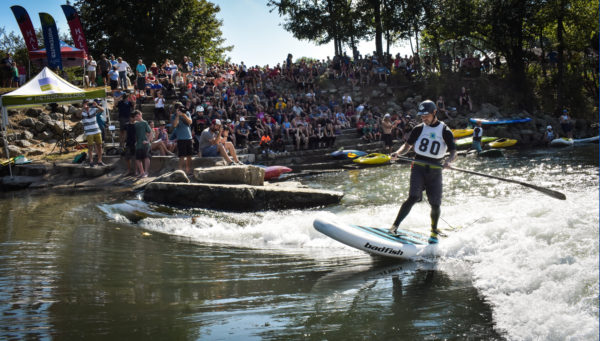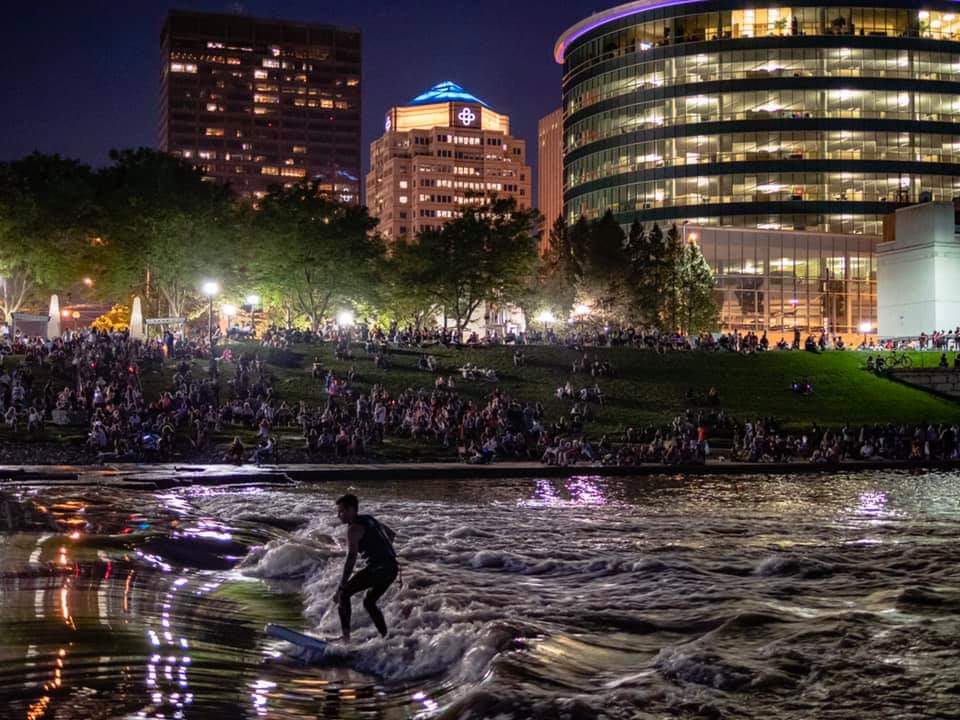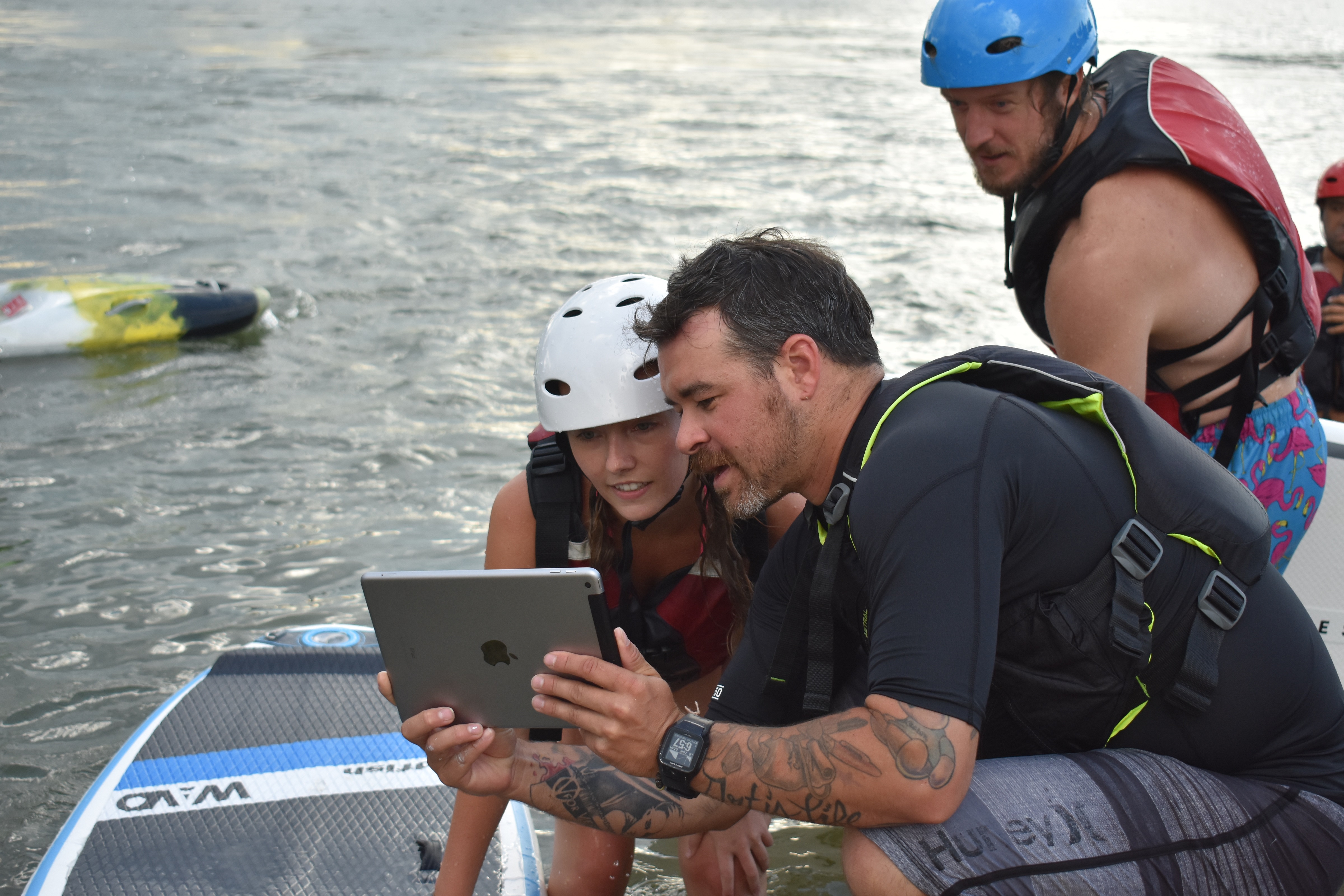When, out of the corner of his eye, Shannon Thomas saw one, two, then three police cars roll up close to him along the Great Miami River in Ohio two years ago, he was more than a little surprised. The experienced water virtuoso was in the middle of the river, and a concerned onlooker had called 911, assuming he was in grave danger.
Thomas was in fact having a whale of a time — surfing the wild post-flood waves that blasted through downtown Dayton. Recalling the day with a wry smile, he says he had multiple safety measures in place. “I had a buddy on the bank; he would watch me and make sure I got back on my board and paddled safely. Then he would go, and I’d watch him,” he says. Clearly, the idea of river surfing was alien to locals. Even the cops offered a scolding, as the incident made national news.

As recently as 2017, river surfing in Midwestern cities ranged from nonexistent to barely nascent. But thanks to forward-thinking urban planners and water enthusiasts in Ohio and elsewhere, sections of early-20th-century low-head dams constructed to keep water upstream were blasted out and now serve as fantastic whitewater play features.
“People aren’t aware that there’s a river there that’s surfable or that there’s a whitewater feature because it’s new,” he says. “But now the dam is gone and the danger is removed. We’re using it to kayak and surf and paddleboard.”
Months after the incident, Thomas, 34, and friend Jake Brown founded Surf Dayton, a company offering classes in river surfing and stand-up paddleboarding (SUP) as a way not just to make a business from a local natural resource, but to get people to interact with the water in new, fun ways.
Thomas estimates that since Surf Dayton began offering courses in July, the number of people getting on the river on SUPs or surfboards has quadrupled. Enthusiasts, including families, have traveled from Kentucky and Pennsylvania for the weekend to take classes, benefiting the city’s long-struggling downtown. Lessons are recorded on an iPad for participants who get instruction on their progress in real time while on the water. The two-person company remains a seasonal effort operating in the summer months. Thomas spends the rest of his working hours as a graphic designer, and he owns an apparel printing company.

Ohio is catching a wave that’s building across the Midwest. Often described as having been born on Munich’s Eisbach River in the 1970s and popular in Rocky Mountain river towns for years, river surfing is now exploding in corn and cotton country. Cities such as Columbus, Ohio, and Oklahoma City, Oklahoma, now boast top-class urban whitewater facilities, while Charles City, Iowa, Siloam Springs, Arkansas, and Montgomery, Alabama, have all turned their disused low-head dams into water playthings. In November, Des Moines, Iowa, was awarded a $25 million grant from the U.S. Department of Transportation to remove dams and construct whitewater and paddling areas, and Grand Rapids, Michigan, has similar plans.
What’s more, while river water quality in the past has been notoriously poor in the industrial Midwest, today it’s far cleaner, meaning new opportunities for recreational river use. These reasons combined have helped make SUP the fastest-growing sport in the United States between 2013 and 2016, topping 3 million participants, and prompted Thomas to paddle-camp the length of Ohio’s Scioto River — a 213-mile journey.
Thomas grew up in Dayton and first started river surfing just five years ago, having previously spent a lot of time kayaking and on a SUP. Brown moved to Dayton from Santa Cruz, California; he was out on the river when he encountered Thomas, who exclaimed, “You know how to surf!” Soon after, they started discussing what would become Surf Dayton and “getting the community involved,” Brown says. “He’s traveled around and seen how tourism can help build a culture in a place.”
Convenience is part of the attraction for Thomas and other surfers. When the waves are right, he hits the river at lunchtime, his board attached to the side of his scooter, and then heads back to work for the afternoon. “If I didn’t have this, I probably wouldn’t be here,” he says. “It’s right downtown; that’s what makes it super accessible.”
It’s a mutually beneficial setup, say officials.

“Many people look at Midwestern states as ‘flyover states’ and do not realize all of the historical charm and actual opportunities we have to offer,” says Amy Dingle of Five Rivers MetroParks, the authority that oversees local whitewater features in Dayton.
To be sure, the waters can be choppy. A drought last autumn meant that rivers across the region ran low for weeks, and changeable weather can make it difficult to organize competitions and get-togethers. Then there’s the costs of converting low-head dams into recreation features — the RiverScape River Run that opened in downtown Dayton in 2017, for example, cost $4 million — that often fall to local governments or private donors.
That said, the convenience and broad appeal of SUP and river surfing, combined with new technologies such as inflatable boards, mean growth in these activities is set to continue.
This year, when surfing makes its Olympic debut at the Tokyo Games, the plan for Surf Dayton is to offer weekend-long surf and paddling camps. Competitions and meetups — called “surf jams” — are also in the works, but Thomas says they’re just for fun.
“Whether I’m surfing out there with one buddy or 10, we’re just out to have a blast.”





Recent Comments